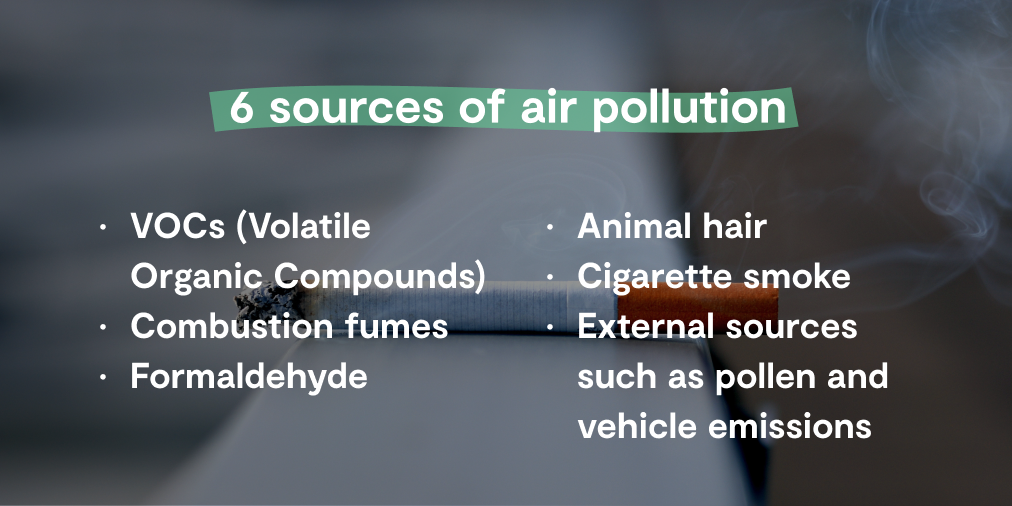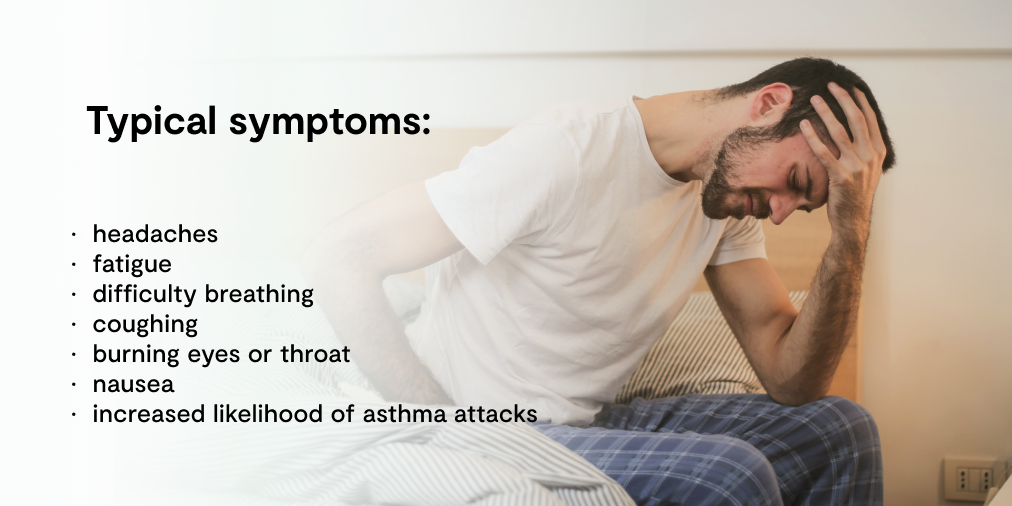
Do air purifiers eliminate odors?
→
Discover how a sustainable air purifier helps eliminate the odors in the spaces where we live every day.
What are odors?
An odor is caused by one or more volatile chemical compounds generally found in low concentrations that humans and many animals can perceive through their sense of smell. An odor can be generated by a single chemical substance or a mixture of chemical substances. The perception of odor can vary between individuals due to differences in their ability to detect certain odors.
Assessing the risks associated with exposure to an odor requires a thorough analysis of the chemical properties of the substances involved and the concentrations at which these substances are present in the air.
It is also essential to consider the different exposure routes (inhalation, ingestion, skin contact) and individual susceptibility to potential health effects.
6 sources of pollution that affect your health
Let's take a look at the sources that can put your home's health at risk. Common causes of indoor air pollution include: VOCs (Volatile Organic Compounds), Combustion fumes, Formaldehyde, Animal hair, Cigarette smoke, External sources such as pollen, and vehicle emissions.
VOCs, Volatile Organic Compounds
Volatile Organic Compounds can come from carpets, cleaning products, and air fresheners. Some examples are xylene, toluene, or benzene. They are really dangerous to our health if found in amounts even just slightly above the safety levels established by the World Health Organization. They are dangerous to our health if found in even slightly higher quantities than the safety levels established by the World Health Organization.

Combustion fumes
The fumes from wood-burning fireplaces or stoves contain carbon monoxide (CO), which is a highly dangerous gas to our health and can even be lethal if levels exceed a certain threshold.
The unique thing about CO is that it is odorless, so it is difficult to tell when levels are too high. And often when levels have reached too high a threshold, we experience physical problems such as lack of clarity, fatigue, or fainting.
Formaldehyde
Formaldehyde is a harmful gas to health, even labeled as carcinogenic by the World Health Organization. It is mainly contained in building materials and insulation and excessive exposure can lead to nose, mouth, and eye irritation, as well as more annoying symptoms such as coughing and skin irritation.
Animal hair
Unfortunately, even our four-legged friends can contribute to indoor pollution if the house is not adequately cleaned. In fact, their hair settles on various surfaces, sometimes even ending up in the air, which humans can breathe in.
We are breathing them in means subjecting our body to irritation, especially in individuals allergic to animal hair despite the allergy. It is essential to avoid this situation as much as possible, which can sometimes lead to asthma attacks, allergies, and irritation of the eyes and nose.

Cigarette Smoke
It is now universally recognized worldwide: smoking harms our health. Smoking cigarettes and cigars carries many dangers that can harm our health and physical well-being. Smoking outside, although still harmful to health, is a necessary choice because smoking inside not only significantly worsens indoor air quality but also endangers the people who live with us, especially children. There is no safe exposure to smoke because any level can harm our bodies. The best choice in these cases is only one: quit smoking. And if so, only smoke outside and never inside the house.
External sources such as pollen and vehicle emissions
Unfortunately, the causes of pollution are not only inside our homes but can also come from outside.
Two of the leading irritating causes for our health are pollen in the spring seasons and vehicle exhaust gases if you live in a busy area, highly exposed to urban smog.
Even in your home, there are Volatile Organic Compounds (VOCs)
Volatile Organic Compounds (VOCs) are common chemical contaminants found in offices and household environments and are a source of odors. VOCs are organic chemicals (containing carbon) that can quickly evaporate into the air. Many products found in the office environment can release VOCs.
Odors are caused by the presence of Volatile Organic Compounds (VOCs) in the air. Often these compounds are considered harmless. However, they can also present long-term health and safety risks.
Today, exposure to volatile organic compounds (VOCs) is inevitable due to the abundance of emission sources. Connections to cancer, asthma, and developmental problems in children are just some of the potential risks identified concerning VOC exposure.

Air purifier: the solution against odors
The fact that Volatile Organic Compounds (VOCs) are so widespread can easily lead people to think they are harmless. The similarity of short-term health effects with other conditions can also make identifying the true root cause harder.
Symptoms of exposure to VOCs depend on the compound, such as benzene, formaldehyde, or toluene. In general, people who are close to products that emit gas may notice the following signs:
- headaches
- fatigue
- difficulty breathing
- coughing
- burning eyes or throat
- nausea
- increased likelihood of asthma attacks.

These symptoms often increase based on the frequency and duration of exposure. This means someone who spends an hour around material in degassing phase may notice any signs. Degassing is the release of gas that is dissolved, trapped, or absorbed on the surface of some materials.
However, sleeping on a new mattress with high VOC content can immediately cause health problems. In the bedroom, we can be exposed to biological pollutants (bacteria, fungi, etc.), physical pollutants (particulates), and chemical pollutants (VOCs, flame retardants, plasticizers, etc.).
The particular interest in the bedroom regarding exposure to VOCs is due to several factors, such as:
- The amount of time we spend in this environment, on average over 30% of the 24 hours for young and adult people and over 50% for infants.
- The presence of many sources of VOCs due to the mattress, sheets, and other furniture. Reduced ventilation in the bedroom during the night.
Previous studies have identified general mattresses and polyurethane foam as significant sources of VOC emissions. Environmental conditions during sleep can influence VOC emissions in this microenvironment.
Eteria: the air purifier that eliminates odors
Eteria is a personal and compact air purifier. It consists of two parts: the air purifier and the monitoring system, composed of as many modules as you want. Thanks to a smart network of modules and mobile purifiers, it performs a complete mapping of your spaces to eliminate pollutants and purify every corner.

Eteria air purifier that eliminates odors sustainable
- Monitor and improve air quality in any space: Connect one or more modules to your device. By purchasing multiple monitoring modules, Eteria performs a complete mapping of your rooms to eliminate pollutants and purify every corner.
- No filters to change and low energy consumption: The risk with a HEPA air purifier over 5 years is to spend hundreds of euros on filters. With Eteria, on the other hand, you have a sustainable and washable photocatalytic filter. Even in energy consumption, Eteria thinks about the environment: it consumes less than an LED light bulb.
The advantages of Eteria's sustainable washable filter: no filter replacement, energy and material savings, and sustainable and effective technology. - Photocatalysis and nanotechnology: We don't collect pollutants, we eliminate them. Nanotechnology attacks pollutants by breaking their chemical bonds and transforming them into harmless substances. The photocatalytic filter treated with WO3 PCO technology eliminates pollutants at the molecular level.
- Air purifier compatible with Alexa and Google Assistant: Eteria can be controlled with voice commands, and thanks to the intuitive "Vitesy Hub" app, you can choose the mode and intensity of purification according to your needs, even in automatic mode. It is easy to connect using the USB-C cable, and usage is intuitive and customizable thanks to compatibility with Amazon Alexa and Google Assistant.
- For any indoor environment: Excellent air purifier for home, office, hotels, hairdressers, beauty centers, and any closed space. It can be moved anywhere you prefer. It is designed to be used near a person and provides a maximum airflow of 34 m3/h. To make product usage easier on a desk for those who work on a computer, the product can also be powered through a USB-C port.





